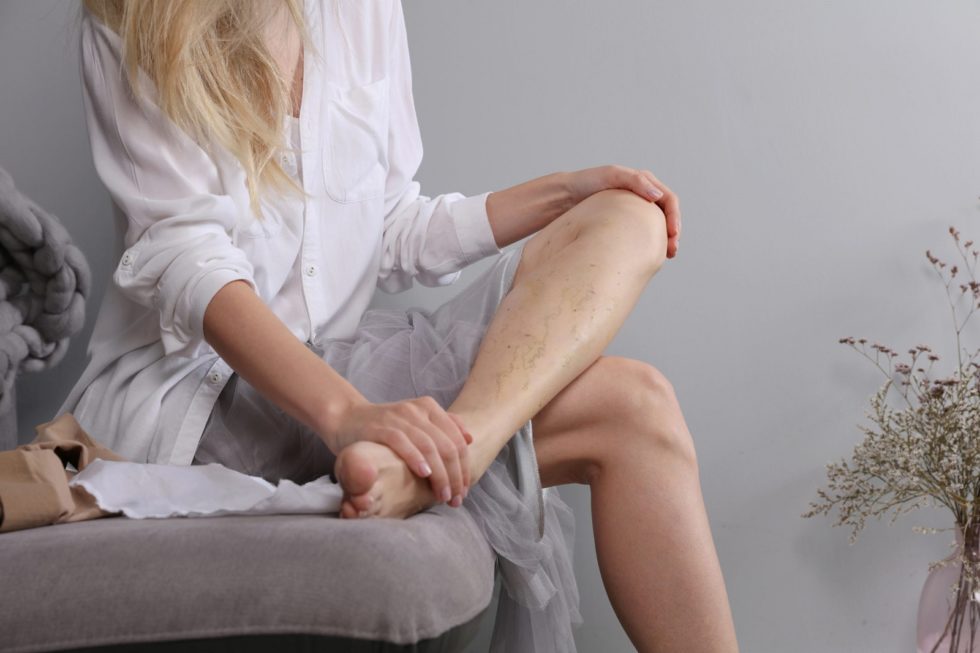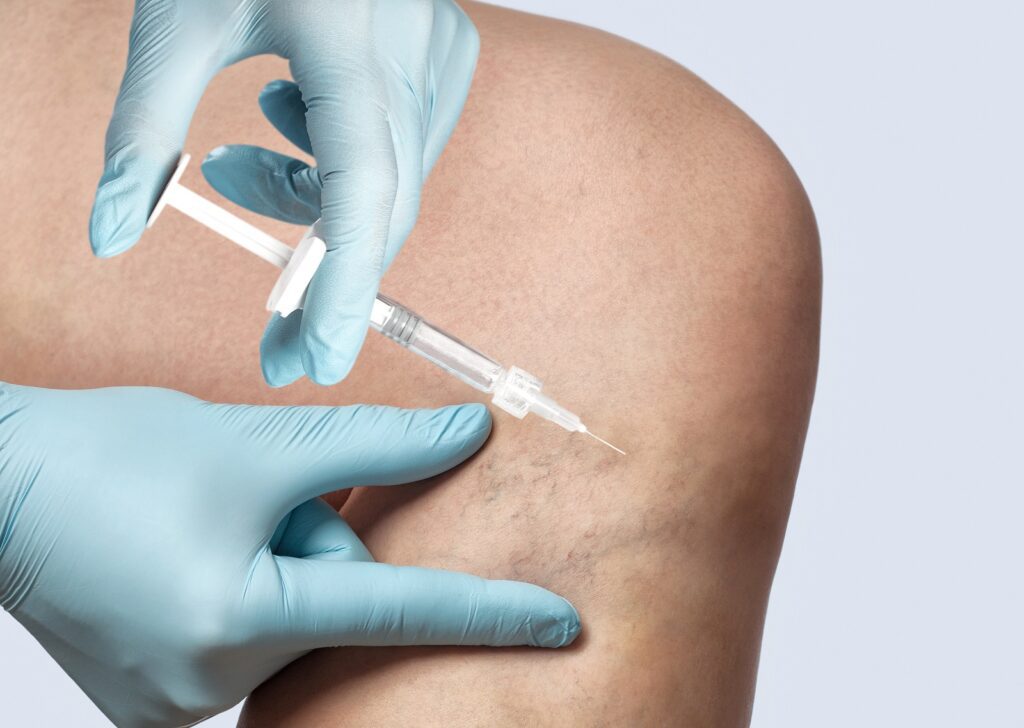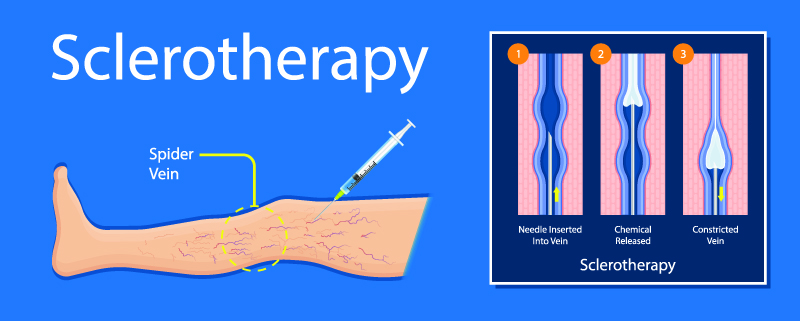Everything You Need to Know About Sclerotherapy for Spider Vein Treatment
Author: StrideCare Internal Team

Joan* never thought there’d come a day when she’d be annoyed and uncomfortable with the appearance of her legs. But she’s noticed more and more web-like blue and purple spider veins on her thighs and calves. It’s gotten to the point lately where she’s constantly wearing long pants to cover them up. The good news is Joan doesn’t have to be stuck with them forever, and even her doctor said she wouldn’t need surgery. Thanks to tremendous medical advancements in technology and equipment, an alternative and minimally invasive procedure called sclerotherapy is perfect for spider vein treatment.
Is Sclerotherapy the Right Spider Vein Treatment for You?
The quick answer is that it depends. More than 20 million Americans suffer from vein disease. Sadly, many of us don’t recognize the signs until the later stages when the condition is more life impacting. Spider veins are painless and more of a cosmetic annoyance than anything else. However they also represent the first sign of changes in the appearance of your legs and should be closely monitored. If necessary, sclerotherapy can provide the spider vein treatment you need to avoid additional complications such as:
- Painful varicose veins
- Blood clots
- Burning, throbbing, itchy legs
- Feelings of leg achiness
- Leg discomfort when sitting or standing
- Cold or numb legs
- Leg muscle cramps
A Brief Overview of Spider Veins
Spider veins, also known as reticular veins, are web-like blue, purple, and red superficial veins on the outer layer of the skin. Your veins typically work on a one-way system using a series of strong valves to ensure the traveling blood doesn’t flow back in the opposite direction with gravity. When we’re young, we don’t think about our veins because they’re usually working just fine. But as we age, so do our veins.
As a result, spider veins form when the valves and walls of our veins are weak. This causes blood to pool in our veins, leading to these unsightly abnormalities in our skin. Unlike varicose veins, which have a bulging and twisted appearance and can become rather painful, spider veins are significantly smaller and aren’t painful at all.
Additional causes of spider veins include:
- Obesity — Pressure is placed on your veins as you carry more weight. This hinders venous return from your legs.
- Heredity — If mom, dad, and grandma all have vein issues, especially spider veins, you are predisposed.
- Excessive standing — Staying on your feet for too long can create undue pressure on your veins.
- Pregnancy — Hormonal changes during pregnancy increases blood volume and stress on vein walls and valves.
- Birth control pills — Using birth control pills, estrogen, and progesterone can cause spider and varicose veins.
Though not painful, spider veins are viewed as the first stage of vein disease and should not be ignored, especially in situations like Joan’s. This is where sclerotherapy for spider vein treatment comes into play.

What Happens During and After Sclerotherapy?
There are two types of spider vein treatment. One is surgery, which involves making an incision and stripping the vein out of the patient’s leg(s). The other is sclerotherapy, where your doctor injects a chemical solution full of sclerosing agent into the affected area. In the second procedure, there are no incisions, though the agent irritates the vein from the inside and causes it to collapse, disappear, and be absorbed into the surrounding tissue.
Essentially, with sclerotherapy what you’re doing is starving troublesome veins of precious blood. And according to at least one study, sclerotherapy shows greater benefits than surgery in terms of treatment success, complication rate, and cost. As a result, the appearance of your legs will look significantly better, and the odds of you developing painful symptoms in the future also decrease.
Here’s How Sclerotherapy works:
Before your treatment begins, an anesthetic may be applied to your treatment area. This is to ensure you are as comfortable as possible throughout your treatment. Once numb, your provider will begin making a series of injections into your affected veins. These injections will introduce the sclerosing agents into the damaged veins, closing them off, and relieving your symptoms. Patients with severe varicose veins and spider veins may require more than one treatment session to achieve their desired results.
Immediately following sclerotherapy treatment, you may notice swelling, bruising, and tenderness around your treated areas. This is normal and typically resolves on its own within a few days of treatment. You may be asked to wear compression socks to help promote blood flow and ensure a quick healing process.

What Happens if My Vein Issues Are Larger?
Sclerotherapy is best suited for small and medium vein issues and improves spider veins on the thighs, calves, and feet. If you’re experiencing painful issues with larger varicose veins, there are a few other options, including:
- Radiofrequency ablation — With RFA, a thin catheter is inserted into the diseased vein through a small puncture that does not leave a scar. Under ultrasound guidance, the catheter is guided up into the great saphenous vein in the thigh or the small saphenous vein in the calf. The radiofrequency energy is delivered to the inside of the vein, heating and sealing the vein closed.
- Microfoam Ablation — This procedure uses a specially formulated microfoam to relieve your symptoms without the use of the heat or tumescent. Microfoam ablation treats enlarged veins, tortuous or twisted veins, and straight veins. Like sclerotherapy and RFA, this minimally invasive procedure typically takes less than an hour to complete and requires minimal downtime and a short recovery period.
StrideCare Is Your Specialist for Spider Vein Treatment
It’s important to recognize vein health issues early and seek help from a medical professional who can guide you on your next steps for spider vein treatment. StrideCare has long been a leader in performing leading-edge procedures to treat a variety of vein conditions, including spider vein treatment, all while providing compassionate patient care.
The vascular physicians at StrideCare are board certified diagnostic radiologists with additional fellowship training in vascular and interventional radiology. They are the top South Texas vein doctors for treating spider veins, leg pain, vein disease, varicose veins, chronic venous insufficiency (CVI), restless leg syndrome, chronic pelvic pain, pelvic congestion syndrome, May-Thurner Syndrome and more—all the while providing compassionate patient care.
The experts at StrideCare will recommend an individualized plan to help you get the best results.
Prior to starting any new treatment or questions regarding a medical condition, always seek the advice of your doctor or other qualified health provider. This information is not a substitute for professional medical advice.
StrideCare serves the South Texas area including Houston, San Antonio, Austin, Round Rock, Bastrop, Brushy Creek, Cedar Park, Converse, Georgetown, Hutto, Kyle, Leander, Marble Falls, New Braunfels, Pasadena, Pearland, Pflugerville, San Marcos, Schertz, Houston, Sugar Land, Katy, Webster, Bay City, Clear Lake, Lake Jackson, The Woodlands, Universal City, Spring, Kingwood, Stafford, Conroe, Texas City, Cypress, League City, Bellaire, and more.
*Patient stories are true. Names and/or photos may be changed to protect patient confidentiality.


